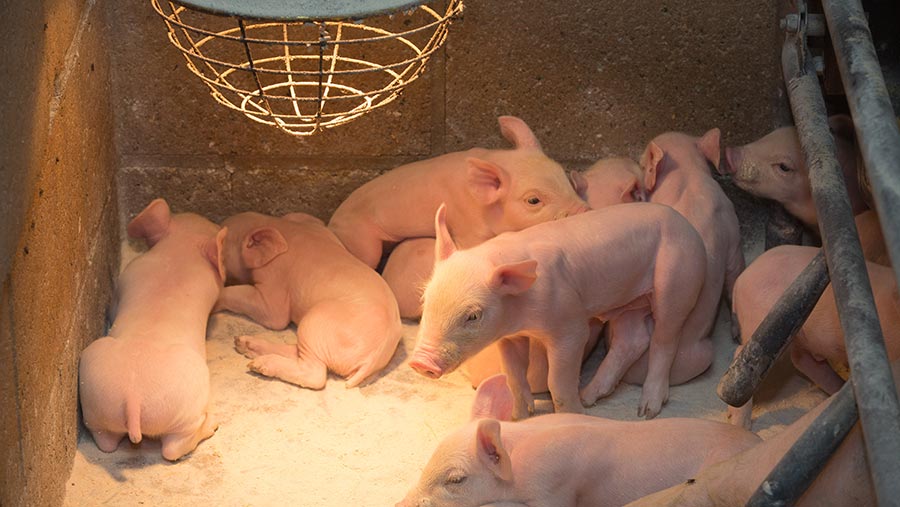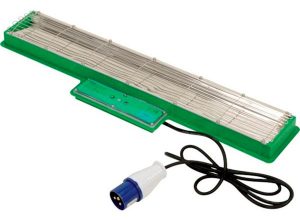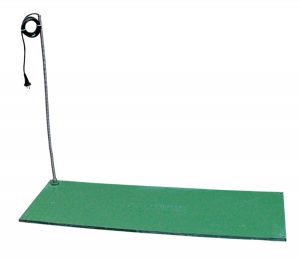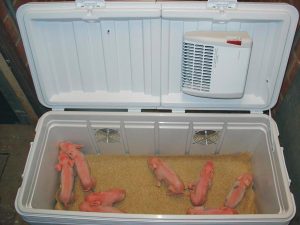4 options for keeping piglets warm
 © Tim Scrivener
© Tim Scrivener Keeping piglets warm is critical to maintaining health and achieving early growth.
But balancing the piglet’s ideal temperature of between 25-30C with the sow’s optimum temperature of 15-18C is difficult within the same airspace of the farrowing house.
For very young, low-weight piglets up to three days old, there is also the threat of hypothermia. Temperatures of up to 34C may be necessary to keep these vulnerable piglets alive.
The risks mean that having a supplementary heat source for piglets is essential. Here we look at a range of options including warming boxes, lamps, radiant heaters and heated pads.
Traditional heat lamp
Pros
- Relatively cheap
- Widely available
- Simple
- Easy to move and re-purpose
Cons
- Risks of burns to piglets
- Risk of glass bulb breakage
- Replacement cost of bulbs
- Provides a small, localised heat area
- Heat rises away from piglets so energy is lost
Description
The traditional heat lamp has been used extensively in agriculture for many decades across different types of youngstock.
It usually has a metal cover to deflect as much heat as possible downwards, and a wire guard to prevent damage to the bulb. Many brands are available, such as the Intelec model we looked at, with wire guard and reducer switch.
Considerations
Local agricultural supply companies will usually stock heat lamps so they are easy to get hold of at short notice. They are quick and easy to move, re-purpose and set up and provide an instant heat source for piglets.
This variant includes a reducer switch to limit the heat output as piglets grow and so cut energy use.
However, heat lamps have a number of shortcomings that need to be considered.
Because the lamp is suspended above the pen, a proportion of the heat rises away from the piglets below. The lamp also has a relatively focused, spot-lit area of heat which may lead to some piglets lying outside its reach.
Siting the lamp must be carried out carefully. It must be set high enough above the pigs so they cannot damage the unit or suffer burns. Glass infra-red bulbs are fragile and could cause injury if broken.
An alternative is to use a ceramic emitter which is more robust and screws into the lamp like a bulb. A further advantage of the emitter is it doesn’t produce light so piglets may be able to rest better in a darker environment.
The big drawback of emitters is that they are more expensive to replace.
Cost
Intelec traditional lamp with wire guard and reducer switch £33.95
Infra-red 250-watt bulb £5.25
Ceramic 250-watt emitter £13.50
Further information
Intelec website: intelec-uk.com
Phone: 01246 264625
Radiant heater (Kramp eHeat)
Pros
- Doesn’t emit light, allowing animals to rest
- Wider area covered than a single heat lamp
- Built-in thermostat reduces temperature gradually
Cons
- Pricier than a heat lamp
- Needs to be mounted into a lid above the piglets
- Heat is overhead so some energy is lost upwards
Description
Available through a wide network of UK dealers, the Kramp unit creates radiant heat rather than light. The Danish manufacturer says this allows animals to rest in darkness.

At 70cm long by 20cm wide the unit provides heat over a larger area than a traditional heat lamp.
A key feature is the built-in thermostat which can be set to switch off the unit when the required ambient temperature is reached.
It can also be set to gradually reduce heat, from 32C on day one post-farrowing to 20C when pigs reach 10 days old.
This leads to a substantial reduction in energy from 25kWh on day one to about 10kWh by day 10.
Considerations
It is less convenient to use than a hanging heat lamp because the eHeat requires mounting into piglet nest cover flaps or the lid of creep feed areas.
However, the opportunity to control temperature more accurately using the thermostat means less input from staff and energy savings.
It is also more difficult to break than a fragile glass bulb and there is not the ongoing cost of replacing bulbs.
Cost: £155 (approximately) per unit
Further information
Kramp UK dealer network
Heat pads
Pros
- Heat rises so energy is used efficiently.
- Pig heat mat sits flat on the floor and fits into creep area
- Provides an even temperature across the mat.
- The temperature can be regulated between 25C-36C
Cons
- Less flexible than heat lamp
- Pricier compared to heat lamp
Description
The flat pads are made of a combined fibreglass/plastic material and lie on the pen floor. Sizes available are: 90 x 40 cm rectangular or 68 x 66 x 68 cm triangle.

Custom sizes can be made when 50 mats or more are ordered.
Used in conjunction with a heat mat controller, the surface temperature can be adjusted between 25C and 36C to meet the requirements of the growing piglets.
Up to 10 mats can be linked to a single controller. The 4.5m electric cable has a metal cover to protect it from chewing.
Considerations
Less energy is wasted than with a top-down heat source because the piglets lie directly on the heated surface.
There is also a lower risk of injury to the piglets through burning compared with a heat lamp or radiant heater.
However, there is a higher initial cost over heat lamps, with a single mat and controller unit costing £180.
Cost
Rectangular heat pad from £89 each
Triangular from £97
Controller for MS heat mats £104 (One required for up to 10 mats)
Further information
Available from MS Schippers 01733 592049 (other heat pad suppliers exist)
MS Schippers website
Piglet incubator
Pros
- Provides all-round heat for cold, wet newborn pigs
- Portable
- Robust
- Easy to clean
Cons
- Specialised equipment useful only for newborns
Description
A large warming box for weak or newborn piglets with outside dimensions of 105cm x 45cm x 45cm. The lidded box has an internal capacity of 150 litres, providing enough space for 20 newborn piglets.

The unit includes an integrated convection heater that draws in fresh air through side vents and circulates warmed air around the box.
The temperature can be adjusted with a digital display on the hinged box lid up to a maximum of 36C.
The manufacturer suggests that piglets can be removed and returned to the sow after about 1-2 hours.
Considerations
The box is a specialist piece of kit rather than an enhancement of the farrowing pen itself. It represents a significant outlay when there may be DIY solutions.
However, the unit provides warm, circulated fresh air around the piglet rather than a directional heat source. The draft-free heat should improve survival rates for cold, wet, hypothermic piglets.
It is made of a durable plastic that can be cleaned and disinfected.
At 35kg the box is portable but its dimensions will mean it is probably a two-person job to move it.
Cost
About €245 (£210)
Further information
Available to import from HCP Technology Germany
Website: HCP-Technology
All prices are guidelines only. Other warming products are available.
